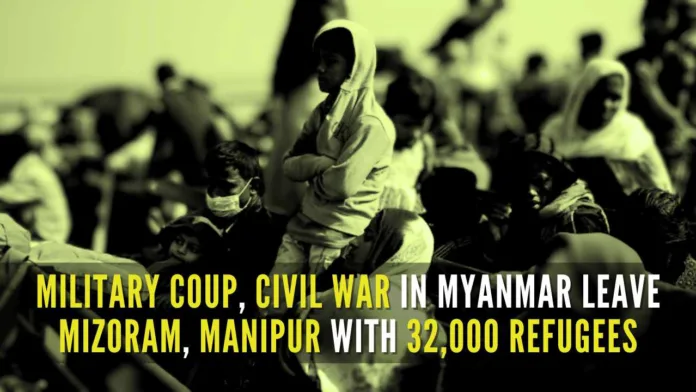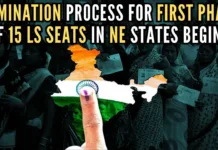
Mizoram, Manipur see a sharp rise in narco smuggling, immigrant influx post-Myanmar coup
India has 1,643 km of unfenced porous borders with Myanmar, the frontiers with Mizoram (510 km) and Manipur (398 km) are most worrying as the illegal influx of Myanmarese, drug peddling and cross-border movement of inimical elements including militants is on the rise.
The northeastern states of India, especially Mizoram and Manipur, have borne the brunt of the Myanmar military’s coup toppling the Aung San Suu Kyi government and seizing power in February 2021.
The complex and rising danger of drug trade and cross-border movement of inimical elements as well as violence-hit civilians have become more challenging for the Indian authorities, especially after the 2021 February coup by the Myanmar military.
At least 40,000 Myanmarese including women and children have taken shelter in Mizoram and Manipur during the past two years after Myanmar went under army control, also known as the ‘Tatmadaw‘, and the subsequent civil war between the army and the pro-democracy ethnic armed forces.
The Myanmar refugees belong to the Chin-Zo tribe and have similar ethnic, cultural, and traditional ties with the Mizos of Mizoram.
The first influx from Myanmar started after the military seized power two years ago. Since then, over 32,000 people, including women, children, and elected leaders, have taken shelter in Mizoram from Myanmar.
Besides the civilians, since November 13 last year, over 255 Myanmarese soldiers also fled to Mizoram in different phases after their camps were captured by armed pro-democracy ethnic groups, who stepped up their battle against the army in early October last year.
Subsequently, the Indian authorities have repatriated the Myanmar army personnel to their country.
Mizoram’s six districts — Champhai, Siaha, Lawngtlai, Serchhip, Hnahthial, and Saitual — share a 510 km unfenced border with Myanmar’s Chin state.
A majority of the refugees live in relief camps and government buildings in Mizoram, while many others are accommodated by their relatives. A large number of Myanmarese have been staying in rented houses.
The state government, Church bodies, Mizoram’s largest voluntary body Young Mizo Association, NGOs, and many individuals are providing food to the refugees, who belong to the Chin tribal community, and who share close ethnic ties with the Mizos besides having language and lifestyle similarities.
The erstwhile Mizo National Front (MNF) government earlier sought financial and logistical support from the Centre for the Myanmar nationals, but the Union government has yet to respond.
Former Chief Minister and MNF supremo Zoramthanga wrote several letters to Prime Minister Narendra Modi and some Central ministers seeking financial and logistical support for the refugees.
Manipur Chief Minister N Biren Singh said that due to the prevailing unrest around 6,000 people from Myanmar have taken shelter in his state in the recent past.
Though the BJP government in Manipur wanted to keep the Myanmar refugees in the designated camps, most of the refugees are staying scattered.
Five Manipur districts — Churachandpur, Chandel, Kamjong, Tengnoupal and Ukhrul — share around a 400-km long border with Myanmar.
Following his predecessor’s strategy, Mizoram Chief Minister Lalduhoma during his recent maiden visit to New Delhi, categorically told Prime Minister Modi, Union Home Minister Amit Shah, and External Affairs Minister S Jaishankar that the Myanmar refugees seeking shelter in Mizoram were not treated differently but as brothers and sisters of the Mizo people.
According to senior officials in Mizoram, Shah gave an assurance to the Chief Minister that Myanmarese refugees in the state would not be deported until complete peace and normalcy were restored in the neighbouring country.
The Home Minister informed Lalduhoma that the policy of the Central government is to take and record fingerprints and biographical details of all the foreigners living in the country.
The previous MNF government turned down the Union Home Ministry’s (MHA) advice to collect biographic and biometric data from the Myanmar refugees last year.
The then Mizoram Information and Public Relations Minister Lalruatkima had said that the collection of biometric details of the Myanmar nationals would be discriminatory as the refugees and the Mizos of Mizoram have the same blood relation and similar ethnicity.
“The MNF government provided relief and shelter to the Myanmar refugees on humanitarian grounds. Thousands of refugee students were enrolled in Mizoram schools and provided free textbooks, uniforms, and mid-day meals like the other students belonging to the state,” Lalruatkima had said.
The Manipur government, however, undertook the collection of biometric details of the Myanmar nationals, sheltered in the state.
As the Manipur government began collecting the biometric data in July last year, a team from the National Crime Records Bureau, deputed by the MHA, assisted the state government at the Foreigners’ Detention Centre at Sajiwa in Imphal East district.
The MHA had earlier asked the Manipur and Mizoram governments to capture biographic and biometric details of “illegal migrants” in the two states.
Citing international protocols and conventions, the MHA earlier told the northeastern states that nationals from neighbouring countries cannot be given “refugee” status as India is not a signatory to the United Nations Convention on Refugees and the protocol.
After the Myanmarese had started entering Mizoram and Manipur since March 2021, the MHA had sent an advisory to four northeastern states — Mizoram, Manipur, Nagaland, and Arunachal Pradesh — which share a 1,640-km unfenced border with Myanmar, saying that the states and UTs have no power to grant “refugee” status to any foreigner, and India is not a signatory to the UN Refugee Convention of 1951 and its 1967 Protocol.
Meanwhile, there is no sign of normalcy returning soon in the war-torn country as in October last year, three ethnic armed groups formed an alliance to begin a major offensive against the military in northern Shan state along the border with China.
There are also reports that the Arakan army already controls key trade routes connecting Bangladesh and the anti-military force is preparing for a final push after having gained effective control over two-thirds of the key coastal province of Rakhine and large parts of the neighbouring Chin state.
The Arakan army’s grouping with the Rohingya Muslim rebel groups aimed to gain global support from the Islamic world.
The military’s airpower is likely to be reinforced by the purchase of Sukhoi fighter-bombers and helicopter gunships from Russia, but there are reports that certain countries are clandestinely supplying the most sophisticated arms and armed drones to the rebel groups.
The military, however, is facing a major challenge from the ethnic rebel groups backed by an exiled National Unity Government (NUG) that is not without its armed groups like the People’s Defence Forces (PDF) and smaller resistance forces in and around the Bamar homeland.
Hostilities in Myanmar would not help the militant outfits belonging to northeast India to retain their bases in that country and local ally (mostly Burmese military commanders in desperate need of armed support).
On the other hand, the Indian government is keen to operationalize important connectivity projects including the Kaladan multi-modal corridor or the Golden Quadrilateral project which would facilitate seamless surface connectivity between landlocked northeast India and the rest of Southeast Asia.
If the Myanmar civil war intensifies, India’s ‘Act East Policy’ is likely to be caught up affecting northeast India.
Experts suggest that India must undertake peace diplomacy in Myanmar for a number of reasons as the country with a 53 million population can help India, especially the northeastern states, in various positive purposes including curbing of illegal drug peddling and militancy.
The United Nations estimates the military has killed at least 2,940 civilians and detained more than 17,000 people, creating a “catastrophic” situation for human rights in Myanmar.
The army’s random use of air raids, artillery shelling, and clashes with groups opposed to its rule — including ethnic armed outfits and the PDF — has displaced more than 1.5 million people nationwide and left some 17.6 million in need of humanitarian assistance.
[With Inputs from IANS]
For all the latest updates, download PGurus App.











Good development & better for India. Burma will now tilt towards India.